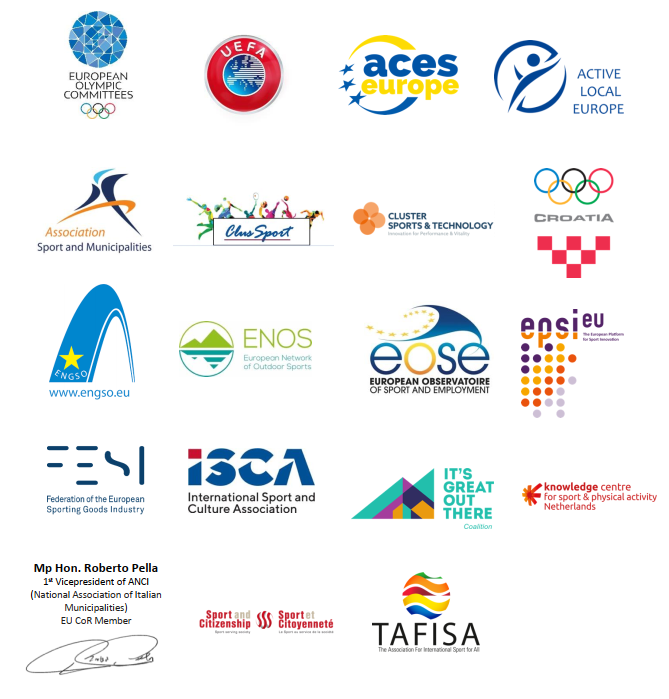The present paper advocates for the inclusion of sport and physical activity in the EU Member States’ National Recovery and Resilience Plans, thereby acknowledging the role of sport and physical activity in a sustainable and healthy recovery process from the COVID-19 pandemic.
Registering an overall impact of approximately €50 billion GDP, the COVID-19 pandemic has hit the sport sector on all levels, from professional to grassroots clubs and venues, affecting employment, citizens participation in sport and physical activity, or diminishing spill-overs in other sectors such as research and innovation, tourism or healthcare.
Identified action plan to create investment opportunities for the sport sector in the recovery process: Given the emergency situation and the vital role that sport and physical activity can play in societies’ recovery process, given the timely deployment of EU recovery mechanisms, immediate action is required to ensure that sport and health-enhancing physical activity will benefit from the national economic investments and reforms supported by the EU funds. Therefore, we call on national ministries responsible for sport to engage in a joint action plan with sport stakeholders and public authorities with the objective of highlighting investment possibilities for sport in the framework of the NRRPs and thus, of increasing opportunities for the sector to access recovery funding. In particular, we encourage national ministries responsible for sport to take the following actions:
1. Involve sport stakeholders in the public consultations for the development of National Recovery and Resilience Plans. Most of the EU Member States are already advanced in the drafting process of the NRRPs, however there might still be time for the various economic sectors to make their voice heard in the negotiations process. National ministries responsible
for sport must argue for the inclusion of the sport sector and sport-related activities in the NRRPs by highlighting the important social and economic benefits sport and physical activity can bring especially against the recovery process the EU is currently undergoing.
2. Identify the main investment areas in the NRRPs and demonstrate how investment in the sport sector and sport-related activities link to these areas. The sport sector can still benefit from the investments outlined in the NRRPs, even if the latter have already been drafted without prior involvement of the sport stakeholders in the consultation process. Ministries
responsible for sport should take responsibility to consult the NRRPs and, jointly with national sport organisations, identify how sport-related initiatives and activities can indirectly contribute to the investment objectives laid down in the NRRPs. This is a crucial action for the sport sector, given the importance of the latter for sustainable development, green transition
processes and health and well-being.
3. Develop appreciation of the implementation and funding allocation processes in each Member State, including the strategic decision-making process on funding priorities and the means of funds’ deployment at national, regional and local levels. Ministries responsible for sport and sport stakeholders active at national level should consult the managing authority
responsible for the drafting and implementation of the NRRPs and understand how the funding deployment and implementation of the planned reforms and investments will occur. This step is extremely important as it enables sport stakeholders to identify who to engage with for the promotion of sport-related initiatives as part of the recovery process at all levels of administration.
4. Develop engagement strategies with managing authorities at national, regional and local levels to make sure the voice of the sport sector is heard. Engagement strategies must be developed to promote the important contribution of sport to the social and economic recovery process and to allow managing authorities to engage with sport stakeholders and to better understand how sport-related initiatives can concretely contribute to the overarching national objectives laid down in the NRRPs.
5. Set out potential for the RRF to support the implementation of sport-related initiatives at regional and local level. Ministries responsible for sport should emphasise the potential of sport and physical activity to stimulate new growth at local and regional levels through its local employment and its expenditure on local goods and services. Ministries should promote
capacity-building at local and regional levels as a bottom-up approach in the process of including sport-related actions in the recovery strategies of EU Member States. Capacity building actions can be jointly implemented with sport organisations disposing of resources at national and local levels in order to empower especially grassroots organisations to unlock
RRF funding for their sport-related initiatives. Moreover, a solidarity mechanism in sport should be implemented by Member States, through the redistribution of funds from other programmes or from the professional sport
sector to grassroots organisations.
Background: A sector reduced and overburdened by the COVID-19 crisis:
In a COVID-19-free scenario,1 in 2020, the sport-related GDP would have accounted for 2.16% of the overall EU-27 economy, amounting to €310.6 billion, while the share of sport-related employment would have reached 2.67% of the total EU-27 employment, an equivalent of 5.2 million persons. The impact has been severe across the EU-27 although the extent of it will depend on how restrictive the COVID-19 measures have been in each specific country. In 2020, the impact of COVID-19 across the sport sector was estimated at just under €50 billion GDP. This has resulted in a reduction of almost 850,000 employees in the sector (16% of all employees in the sector).2 Almost all Member States were estimated to see their share of sport-related GDP decline by at least 10% in 2020.
The pandemic has affected all levels of sport, from professional to grassroots and associated industries, such as retail and sport facilities, sport federations, clubs, holders of sport infrastructure or active tourism.
Moreover, sport and physical activity have a vital role in helping societies and economies to recover from the pandemic:
· Small clubs and associations (both non-profit and commercial) play a key role in allowing so many citizens to take part in affordable activities and to enjoy sport and physical activity on a daily basis.
· The sport sector actively contributes to research and innovation and thus to the survival of SMEs who are developing products and services which address the societal issue of inactivity and health.
· The lockdown measures will result in a longer-term decline in both participation in sport and physical activity levels, with an important impact on society’s health and wellbeing.
As facilities start to open, additional severe consequences have risen:
· Having not sustained the crisis, potentially some sport centres and sport clubs may had to be closed thereby reducing possibilities and offers at the local levels;
· Consequently, citizens may find it difficult to return to their previous sport and physical activity levels. Groups who have been more severely affected by the pandemic such as people living in disadvantaged conditions or with long-term comorbidities may face particular barriers in raising their activity routine.
Unless action is taken, the above-mentioned consequences may lead to a deterioration of physical and mental health, thus contributing to the increase in the prevalence of non-communicable diseases.
As a result, the economic costs of physical inactivity are likely to soar across the EU.
Recovery and Resilience Facility: an important support opportunity for the sport sector: As the COVID-19 crisis continues to deepen its effects on the overall society and economy, the European Commission has started to roll-out various support instruments, as part of the major recovery mechanism branded Next Generation EU. With a budget of € 750 billion, Next Generation EU aims to address the socio-economic damage created by the pandemic and to start building a more resilient, sustainable and healthier society capable of better facing future global health and economic
threats. This budget will be disbursed in the next 3 to 6 years through several funding instruments.
As the centrepiece of Next Generation EU, the Recovery and Resilience Facility (RRF) will channel almost 90% of the Next Generation EU budget (€ 672.5 billion) to support Member States in achieving an economic and social recovery, resilience and convergence, especially against the backdrop of the green and digital transitions. To access the Facility, Member States need to prepare National Recovery and Resilience Plans (NRRPs) setting out their reform and public investment agendas to be
implemented between 2021 and 2026. Final drafts of NRRPs must be submitted to the European Commission by 30 April 2021 (although some EU Member States may have negotiated certain delays in submitting the drafts).
The sport sector is in a position to derive benefit from support through the Recovery and Resilience Facility4, not only as a hard-hit sector in need of reconstruction, but as a strategic sector with a meaningful impact on Europe’s wider economic, resilience and social recovery process, not least by its power to mobilise and motivate diverse groups across society. The European Union has an important role to play in this context by promoting the societal and economic function of sport and
by mainstreaming sport and physical activity across the EU funding and support programmes.
Sport and physical activity can bring important contributions to the main thematic areas of investment privileged by the RRF, especially:
· the transition to a green economy and society;
· building economic and social resilience and a better health for EU citizens;
· fostering a sustainable and inclusive growth;
· policies for the next generation, children and the youth.
Concretely, the seven European Flagship Areas for investment and reforms that must be prioritised in the NRRPs provide important investment opportunities in the sport sector, which would not only support the recovery of the latter, but would also contribute to achieving the overarching EU objectives of transition and resilience. The table below highlights such investment opportunities.
| European flagship areas | Possible investment opportunities for the sport sector5 |
| Power Up: Clean technologies and renewables | Facilitate the use of renewable energy and waste heat in large sport facilities both large scale and local (i.e. network of sport infrastructures at national level). Use sport organisations’ extensive networks on the ground to mobilise community action to adopt clean technologies. |
| Renovate: Energy efficiency of buildings | Renovate outdated sport infrastructure to increase the energy, resource efficiency and enhanced biodiversity around sport facilities. |
| Recharge and refuel: Sustainable transport and charging stations | Create alternative mobility frameworks (e.g. cycle highways) in cities and urban agglomerations. Create community trail networks that connect rural villages, towns and communities, fostering active commuting. Create and promote efficient and networked public transport, through electric and Smooth Mobility. |
| Connect: Roll-out broadband services | Build capacities for the development of novel services making use of broadband, using AI or the Internet of Things to enable sport and physical activity to encourage healthier lifestyles. |
| Modernise: Digitalisation of public administration and services | |
| Scale-up: Increase in European data cloud capacities and sustainable processors | Support the development of cutting-edge European interconnected and energy efficient cloud-to-edge data centres for the public sector, including sport organisations. Develop data mapping and big data analysis. |
| Reskill and upskill: Education and training to support digital skills and climate transformation | Support the development of both direct and soft skills through sport training curricula in dedicated centres, using sport’s wide engagement with social groups, especially at a local community level. Promote the value of volunteers and provide opportunities for volunteers to learn and up-skill. |
Taking all of the above into account, the reinforcement of the potential of sport and physical activity is urgently needed. Long-term sustainable development strategies highlighting the value of sport and physical activity as an important contributor to urban and rural regeneration, health and well-being, job creation and economic sustainable growth should be at the forefront of COVID-19 recovery plans. Member States must recognise that sport is a cross-sectoral tool to reach public policy goals. Relevant government departments should consider support to sport and physical activity when developing and implementing their specific recovery plans.
Signatories of the Position Paper SHARE initiative members:


